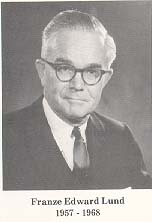|
|
Kenyon College in the 1960s |
|
|
Through the efforts of the administration and College supporters under Gordon Keith Chalmers (president of the college from 1937-1956), Kenyon was able to survive and even thrive during the war years. Kenyon College Statistics in early 1960s
|
|
|||||||
| Kenyon Presidents in the 1960s | ||||||||
 |
After the unexpected death of Gordon Keith Chalmers in 1956, Dean of Students Bailey served as acting president until a successor was named. Arriving at Kenyon in 1957, Lund became, against his desires, a "brick and mortar" president. One of the most noteworthy of accomplishments of the Lund administration was the addition of new facilities to the physical plant of the College. These new buildings included Phillip Mather Science Hall, Dempsey Hall, Chalmers Memorial Library, Gund Hall, Farr Hall, Bushnell Hall, and Manning Hall. Lund's administration also expanded the College's enrollment from 511 to 800 students, set plans in motion for the co-ordinate women's college, and saw the relocation of Bexley Seminary. Lund resigned as president in 1968. | |||||||
|
Mt. Vernon sign 1963 |
|
|||||||
| After President Lund announced his retirement, the executive committee of the College set about finding a suitable replacement. They immediately turned to William Goff Caples, a member of the Board of Trustee's and a Kenyon Alumnus. | ||||||||
| During the Caples administration, many of the long-term plans started by the Lund administration
were finally implemented. These plans included, most notably, the establishment of the co-ordinate women's college
in 1969. Dealing with campus unrest and increased student activism, William Caples remained president of the College
until 1975 when he was succeeded by Phil Jordan.. Click Here to visit the Kenyon Women's Oral History Project Click Here to visit the Kenyon 1960s Activism Project |
|
|||||||